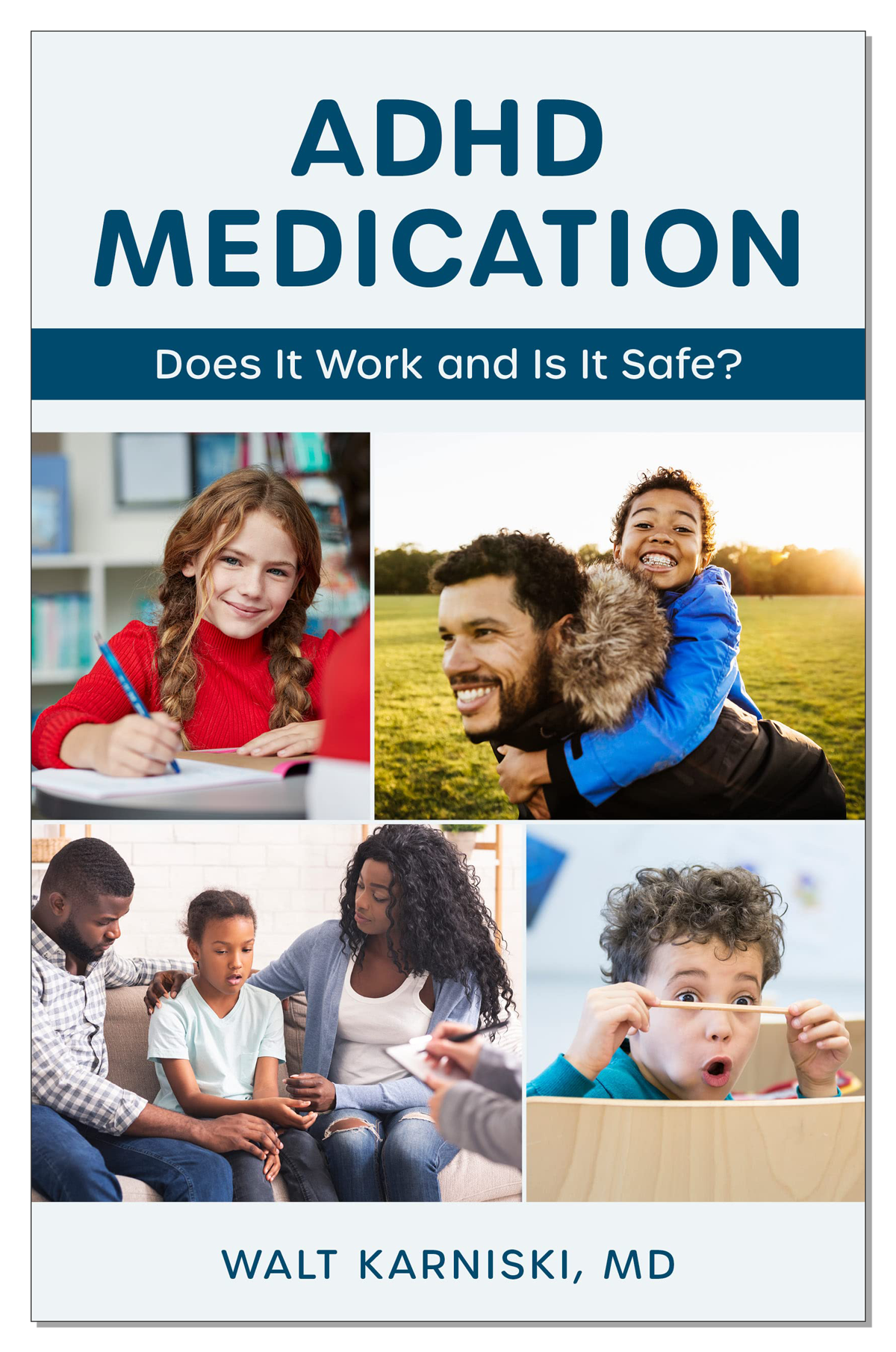Chapter Headings
1 What Is ADHD and How Has It Evolved? (page 1)
This chapter begins with a description of why I wrote this book. The use of medication for children with ADHD is not a decision that should be made lightly. It is my hope that parents will use this book to better understand the many medications options and that this knowledge will allow for a parents to have an intelligent conversation with their physicians about the use of medication to treat ADHD. This chapter also presents a brief history of the diagnosis of ADHD, beginning in 1763 and ending with an explanation of how ADHD is currently diagnosed. However, the last few pages of this chapter present a surprising and completely different way of envisioning ADHD, from the stand point of a single child.
2 What Is ADHD and How Does It Feel? (page 17)
One parent who brought her one child to see me for the first time also brought a notebook with her. This notebook was a calendar which allowed the teacher to make daily comments on her child’s performance in the classroom. The parents could then respond to the teacher’s comments and add insights of their own. This chapter paints a portrait of a single, real child and what it feels like to the teacher, to the parents, but most importantly, to the child. After reading this chapter you will have the most complete description of what is feels like to be a seven year old child with ADHD.
3 From Silk to Ritalin: A History of the Medical Treatment of Attention Deficit Hyperactivity Disorder (page 49)
Chapter 3 presents of history of the use of stimulant medication to treat ADHD. The chapter begins with the discovery of a chemical substance in the ephedra plant over 120 years ago. Later, the chapter describes the first use of this medication for the treatment of behavioral difficulties in 1940. The chapter traces the history of a medication that was initially used for chronic congestion, then for the treatment of obesity and ends with an understanding of how the pharmaceutical companies developed Ritalin and Adderall as a treatment for ADHD.
4 Is ADHD Really Real? (page 61)
This chapter begins with a discussion of how often ADHD occurs. We learn that it occurs inn approximately 7% of the population. Many people, parents and professionals feel that ADHD is over diagnosed and arguments to support this conclusion or to refute it are discussed. This chapter discusses the possibility that ADHD is not a disease at all, but is a product of our evolution as human beings. This chapter concludes with an explanation of what is happening in the brain of a child with ADHD and how medication works within the brain to change the behavior of a child
5 Could ADHD Medication Help My Child? (page 81)
This chapter examines three ways that medication could be shown to be helpful for a child with ADHD. The first method is to examine what happens to the behavior of a child with ADHD when he or she is treated with medication. The second method uses research from thousands of studies to demonstrate the effect of medication in children with ADHD. The final method first examines the effect of ADHD on the eventual life outcomes for children with ADHD when they become adults. Children with ADHD have difficulties with just about every aspect of their lives, but the research shows that children treated with medication are as successful in life as children who do not have ADHD. Finally, this chapter reveals the long-term effects on the brain of taking ADHD medication for years.
6 Why Are There So Many Different Medications for the Treatment of ADHD? (page 103)
Most people have heard of a few of the medications used to treat ADHD (Ritalin, Adderall, Vyvanse and many others). Yet, you might be surprised to learn that there are 46 medications approved by the FDA for the treatment of ADHD. This chapter reveals the stunning ways that pharmaceutical companies repackage medication to gain FDA approval and how this repackaging allows them to take a medication that is inexpensive to produce and charge grossly inflated prices. 36 of these medications are stimulant medications (the other 10 medications are referred to as non-stimulants), and stimulants are the most effective medication treatment for ADHD. But the revalation that these 36 medications are composed of only two different medications (methylphenidate and amphetamine) is even more surprising. Pharmaceutical conmopaniues will take these two medciatioins that last only 3-4 hours, and produce a long-acting alternative. Or they will use a different delivery system (liquid, orally disolving tablet, chewable tablet, pro-drug or skin patch). Or they will alter the ratio of amphetamine to its mirror image molecule, an alternation which has no practical valuae but does allow the emergence of another group of expensive brand name medications. This process increases profits for the pharmaceutical companies, but also benefits the patient with ADHD, because there are now many alternatives to customize the treatment to meet an individual child’s needs. This chapter also discusses the difference between brand name ands generic medications and the concept of evergreening.
- 7 Which Medication Is Right for My Child? 125
There are 4 main medication characteristics that differentiate all ADHD medications, and the four characteristics often determine which medication a physician might recommend for the treatment of ADHD. These four characteristics are:
1. Medication Duration Time (How long throughout the day is a medication effective?)
2. Delivery Mechanism (How does the medication get from the bottle to the brain?)
3. Medication Mirror-Image Molecules (A medication can exist in two forms that are mirror images of each other—how do these forms contribute to the efficacy of a medication?)
4. Medication Cost
Children need to know why they are taking these medications and this chapter also explains how to talk to your child about the medication treatment of ADHD
8 Stimulant Medication Side Effects 139
Every medicatioin has side effects. When the FDA is reviewing an application for a new drug, it does not insist that the medication have no side effects, but if the benefits are signigicant, if side effects are mild and if the benefirts signiticantly outweight the side effects, then the mediciatno willl usually gain approval. The side effects to the ADHD medications are relatively common, but none of the side effects of stimhulant medication will continue after medication has been discointinjed. None of these side effects are severe, and these side effects can often be minimized to that the medication can still be used. Finally, none of these side effects are serious, life-threatening or irreversible. The most commmon sidse effects of stimulant medication are:
- Decreased apetite
- Insomnia
- Emotional Lability
- Mood Suppression (the “Zombie Effect”)
- Headachdes and stomachaches
- Tics (not actually a side effect)
- Cardiac (effect on heart rate and blood pressure)
9 Comorbidity: ADHD Does Not Dance Alone 177
About 70% of children with ADHD will also have emotional and behavioral difficulties that often accompany their ADHD, but are not part of the singular diagnosis of ADHD. These behviorrs are referred to as Comorbid Behaviors. These behaviors can complicate the treatment, because while stimulant medication almost always reduces the ADHD symptoms, they usually increase the comorbid behaviors. These behaviors fit into 4 different categories:
- Oppositional-Defiant
- Dysphoric Mood
- Anxiety
- Compulsive Behaviors
Children with ADHD can also have autistic behaviors, sleep disorders and learning disabilities, but these behaviors are not reviewed in this chapter.
This chapter discusses how to moderate the comorbid behaviors and discusses the non-stimulant mediccation treatment of ADHD.
10 Twenty Brand-Name Methylphenidate Medications to Treat ADHD 193
11 Sixteen Brand-Name Amphetamine Medications to Treat ADHD 227
12 Ten Non-Stimulant Medications to Treat ADHD 251
- Is the most comprehensive book on ADHD medications written for parents
- Uses frequent fictional stories to simplify the complexity of the scientific concepts without surrendering scientific integrity.
- Examines how effective ADHD medications are from three distinct viewpoints
- Explains the advantages and disadvantages of each of the 46 medications used to treat ADHD
- Informs parents about the side effects of ADHD medications and how to minimize or eliminate side effects
- Presents the standard method for diagnosing ADHD. However, in addition, Dr. Karniski presents a heartbreaking true story of a single child with ADHD and through this child, explains the effect of ADHD on the Teacher, the School, the Family and the Child himself

Does medication work?
And is it safe?
The treatment of ADHD with medication has been marked by fierce debate and criticism. For parents deciding whether and how to treat their child for ADHD with medication, this book examines all aspects of medication treatment, including medication effectiveness, side-effects and their management, brand name vs. generics, and medication safety.
ADHD often causes parents to feel guilt and failure, and children to feel rejection by peers, criticism from teachers and blame from parents.
This book allays these concerns and answers the questions you have been asking.
Dr. Karniski is a Developmental Pediatrician with over 40 years of experience, having treated thousands of children with ADHD. He has developed and operated three schools for children with ADHD, anxiety and learning disabilities. His book explores scientific concepts, but does so in an engaging way, using stories of real patients to explain and simplify the complexity without compromising the science. This book answers questions about ADHD medication. Does it work? Is it safe?

